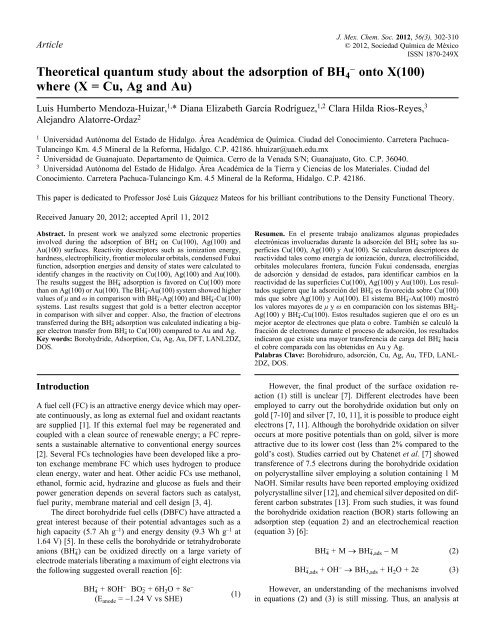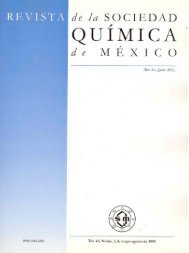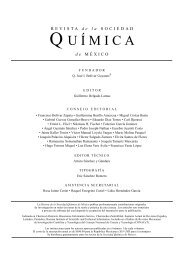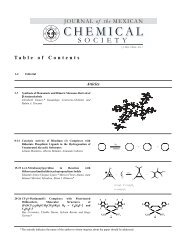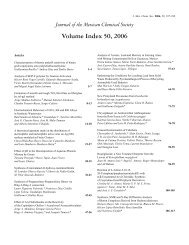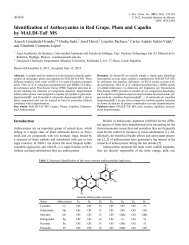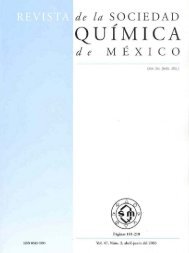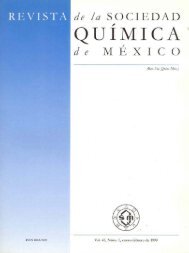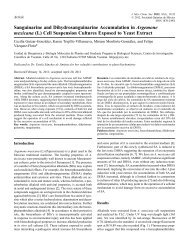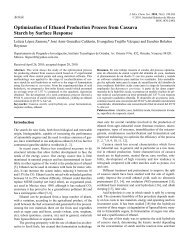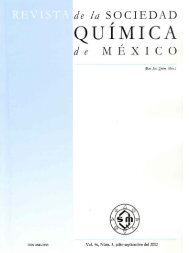Theoretical quantum study about the adsorption of BH4 - onto X(100 ...
Theoretical quantum study about the adsorption of BH4 - onto X(100 ...
Theoretical quantum study about the adsorption of BH4 - onto X(100 ...
Create successful ePaper yourself
Turn your PDF publications into a flip-book with our unique Google optimized e-Paper software.
J. Mex. Chem. Soc. 2012, 56(3), 302-310<br />
302<br />
Article<br />
J. Mex. Chem. Soc. 2012, 56(3)<br />
©<br />
Luis<br />
2012,<br />
Humberto<br />
Sociedad<br />
Mendoza-Huizar<br />
Química de México<br />
et al.<br />
ISSN 1870-249X<br />
<strong>Theoretical</strong> <strong>quantum</strong> <strong>study</strong> <strong>about</strong> <strong>the</strong> <strong>adsorption</strong> <strong>of</strong> BH 4<br />
-<br />
<strong>onto</strong> X(<strong>100</strong>)<br />
where (X = Cu, Ag and Au)<br />
Luis Humberto Mendoza-Huizar, 1, * Diana Elizabeth García Rodríguez, 1,2 Clara Hilda Rios-Reyes, 3<br />
Alejandro Alatorre-Ordaz 2<br />
1<br />
Universidad Autónoma del Estado de Hidalgo. Área Académica de Química. Ciudad del Conocimiento. Carretera Pachuca-<br />
Tulancingo Km. 4.5 Mineral de la Reforma, Hidalgo. C.P. 42186. hhuizar@uaeh.edu.mx<br />
2<br />
Universidad de Guanajuato. Departamento de Química. Cerro de la Venada S/N; Guanajuato, Gto. C.P. 36040.<br />
3<br />
Universidad Autónoma del Estado de Hidalgo. Área Académica de la Tierra y Ciencias de los Materiales. Ciudad del<br />
Conocimiento. Carretera Pachuca-Tulancingo Km. 4.5 Mineral de la Reforma, Hidalgo. C.P. 42186.<br />
This paper is dedicated to Pr<strong>of</strong>essor José Luis Gázquez Mateos for his brilliant contributions to <strong>the</strong> Density Functional Theory.<br />
Received January 20, 2012; accepted April 11, 2012<br />
Abstract. In present work we analyzed some electronic properties<br />
involved during <strong>the</strong> <strong>adsorption</strong> <strong>of</strong> BH 4<br />
-<br />
on Cu(<strong>100</strong>), Ag(<strong>100</strong>) and<br />
Au(<strong>100</strong>) surfaces. Reactivity descriptors such as ionization energy,<br />
hardness, electrophilicity, frontier molecular orbitals, condensed Fukui<br />
function, <strong>adsorption</strong> energies and density <strong>of</strong> states were calculated to<br />
identify changes in <strong>the</strong> reactivity on Cu(<strong>100</strong>), Ag(<strong>100</strong>) and Au(<strong>100</strong>).<br />
The results suggest <strong>the</strong> BH 4<br />
-<br />
<strong>adsorption</strong> is favored on Cu(<strong>100</strong>) more<br />
than on Ag(<strong>100</strong>) or Au(<strong>100</strong>). The BH 4 - -Au(<strong>100</strong>) system showed higher<br />
values <strong>of</strong> μ and ω in comparison with BH 4 - -Ag(<strong>100</strong>) and BH 4 - -Cu(<strong>100</strong>)<br />
systems. Last results suggest that gold is a better electron acceptor<br />
in comparison with silver and copper. Also, <strong>the</strong> fraction <strong>of</strong> electrons<br />
transferred during <strong>the</strong> BH 4<br />
-<br />
<strong>adsorption</strong> was calculated indicating a bigger<br />
electron transfer from BH 4<br />
-<br />
to Cu(<strong>100</strong>) compared to Au and Ag.<br />
Key words: Borohydride, Adsorption, Cu, Ag, Au, DFT, LANL2DZ,<br />
DOS.<br />
Resumen. En el presente trabajo analizamos algunas propiedades<br />
electrónicas involucradas durante la adsorción del BH 4<br />
-<br />
sobre las superficies<br />
Cu(<strong>100</strong>), Ag(<strong>100</strong>) y Au(<strong>100</strong>). Se calcularon descriptores de<br />
reactividad tales como energía de ionización, dureza, electr<strong>of</strong>ilicidad,<br />
orbitales moleculares frontera, función Fukui condensada, energías<br />
de adsorción y densidad de estados, para identificar cambios en la<br />
reactividad de las superficies Cu(<strong>100</strong>), Ag(<strong>100</strong>) y Au(<strong>100</strong>). Los resultados<br />
sugieren que la adsorción del BH 4<br />
-<br />
es favorecida sobre Cu(<strong>100</strong>)<br />
más que sobre Ag(<strong>100</strong>) y Au(<strong>100</strong>). El sistema BH 4 - -Au(<strong>100</strong>) mostró<br />
los valores mayores de μ y ω en comparación con los sistemas BH 4 - -<br />
Ag(<strong>100</strong>) y BH 4 - -Cu(<strong>100</strong>). Estos resultados sugieren que el oro es un<br />
mejor aceptor de electrones que plata o cobre. También se calculó la<br />
fracción de electrones durante el proceso de adsorción, los resultados<br />
indicaron que existe una mayor transferencia de carga del BH 4<br />
-<br />
hacia<br />
el cobre comparada con las obtenidas en Au y Ag.<br />
Palabras Clave: Borohidruro, adsorción, Cu, Ag, Au, TFD, LANL-<br />
2DZ, DOS.<br />
Introduction<br />
A fuel cell (FC) is an attractive energy device which may operate<br />
continuously, as long as external fuel and oxidant reactants<br />
are supplied [1]. If this external fuel may be regenerated and<br />
coupled with a clean source <strong>of</strong> renewable energy; a FC represents<br />
a sustainable alternative to conventional energy sources<br />
[2]. Several FCs technologies have been developed like a proton<br />
exchange membrane FC which uses hydrogen to produce<br />
clean energy, water and heat. O<strong>the</strong>r acidic FCs use methanol,<br />
ethanol, formic acid, hydrazine and glucose as fuels and <strong>the</strong>ir<br />
power generation depends on several factors such as catalyst,<br />
fuel purity, membrane material and cell design [3, 4].<br />
The direct borohydride fuel cells (DBFC) have attracted a<br />
great interest because <strong>of</strong> <strong>the</strong>ir potential advantages such as a<br />
high capacity (5.7 Ah g –1 ) and energy density (9.3 Wh g –1 at<br />
1.64 V) [5]. In <strong>the</strong>se cells <strong>the</strong> borohydride or tetrahydroborate<br />
anions (BH 4 - ) can be oxidized directly on a large variety <strong>of</strong><br />
electrode materials liberating a maximum <strong>of</strong> eight electrons via<br />
<strong>the</strong> following suggested overall reaction [6]:<br />
However, <strong>the</strong> final product <strong>of</strong> <strong>the</strong> surface oxidation reaction<br />
(1) still is unclear [7]. Different electrodes have been<br />
employed to carry out <strong>the</strong> borohydride oxidation but only on<br />
gold [7-10] and silver [7, 10, 11], it is possible to produce eight<br />
electrons [7, 11]. Although <strong>the</strong> borohydride oxidation on silver<br />
occurs at more positive potentials than on gold, silver is more<br />
attractive due to its lower cost (less than 2% compared to <strong>the</strong><br />
gold’s cost). Studies carried out by Chatenet et al. [7] showed<br />
transference <strong>of</strong> 7.5 electrons during <strong>the</strong> borohydride oxidation<br />
on polycrystalline silver employing a solution containing 1 M<br />
NaOH. Similar results have been reported employing oxidized<br />
polycrystalline silver [12], and chemical silver deposited on different<br />
carbon substrates [13]. From such studies, it was found<br />
<strong>the</strong> borohydride oxidation reaction (BOR) starts following an<br />
<strong>adsorption</strong> step (equation 2) and an electrochemical reaction<br />
(equation 3) [6]:<br />
BH 4<br />
-<br />
+ M → BH 4<br />
- ,ads - M (2)<br />
BH 4<br />
- ,ads + OH - → BH 3,ads + H 2 O + 2ē (3)<br />
BH 4<br />
-<br />
+ 8OH - BO 2<br />
-<br />
+ 6H 2 O + 8e -<br />
(E anode = -1.24 V vs SHE)<br />
(1)<br />
However, an understanding <strong>of</strong> <strong>the</strong> mechanisms involved<br />
in equations (2) and (3) is still missing. Thus, an analysis at
<strong>Theoretical</strong> <strong>quantum</strong> <strong>study</strong> <strong>about</strong> <strong>the</strong> <strong>adsorption</strong> <strong>of</strong> BH 4<br />
-<br />
<strong>onto</strong> X(<strong>100</strong>) where (X=Cu, Ag and Au) 303<br />
electronic level would allow an efficient design <strong>of</strong> new materials<br />
to carry out <strong>the</strong> borohydride oxidation. From equation (2)<br />
note <strong>the</strong> first step previous to <strong>the</strong> oxidation reaction <strong>of</strong> BH 4<br />
-<br />
is<br />
<strong>the</strong> borohydride <strong>adsorption</strong>, which may change <strong>the</strong> electronic<br />
properties <strong>of</strong> <strong>the</strong> substrate and its behavior during <strong>the</strong> oxidation<br />
route. Recently, <strong>the</strong> borohydride <strong>adsorption</strong> on Pt(111) and<br />
Au(111) surfaces was studied employing Density Functional<br />
Theory (DFT). It was found <strong>the</strong> initial <strong>adsorption</strong> step dictates<br />
<strong>the</strong> activity <strong>of</strong> gold and platinum anodes [8]. However, in such<br />
studies an analysis <strong>of</strong> <strong>the</strong> molecular reactivity involved during<br />
<strong>the</strong> <strong>adsorption</strong> was not done.<br />
Seemingly silver and gold are <strong>the</strong> best electrodes to get a<br />
transfer <strong>of</strong> eight electrons during BOR. Here it is interesting<br />
to note that copper shows a similar electronic configuration to<br />
<strong>the</strong> presented by gold and silver. However, copper surface has<br />
not been employed as DBFC anodes. This is because <strong>of</strong> <strong>the</strong><br />
<strong>the</strong>rmodynamical oxidation potential <strong>of</strong> Cu (+0.159 V) is more<br />
positive than <strong>the</strong> BOR (-0.45 V). However, it is important to<br />
consider that an <strong>adsorption</strong> process may change <strong>the</strong> electronic<br />
properties <strong>of</strong> <strong>the</strong> surface including its oxidation potential. It<br />
has been reported that Cu, Ag and Au show a periodic pinpoint<br />
distribution <strong>of</strong> <strong>the</strong> electrophilic actives sites [15-17]. Thus, it is<br />
possible to suggest <strong>the</strong> BH 4<br />
-<br />
<strong>adsorption</strong> on to <strong>the</strong>se metals may<br />
show a periodic behavior. Therefore, in this work we examine<br />
some reactivity descriptors and <strong>the</strong> distribution <strong>of</strong> active sites<br />
<strong>of</strong> <strong>the</strong> monocrystalline surfaces <strong>of</strong> Cu, Ag and Au with (<strong>100</strong>)<br />
orientation caused by borohydride <strong>adsorption</strong>. We consider <strong>the</strong><br />
results gained will allow getting a major understanding to select<br />
<strong>the</strong> substrates used during <strong>the</strong> BOR.<br />
Theory<br />
From DFT it is possible to define universal concepts <strong>of</strong> molecular<br />
stability and reactivity such as electronic chemical potential<br />
(μ), absolute hardness (η), and global electrophilicity index (ω)<br />
[18-24]. The electronic chemical potential μ was defined by<br />
Parr et al [25] as<br />
1<br />
2 ( I A )<br />
(4)<br />
where, μ is characteristic <strong>of</strong> electronegativity <strong>of</strong> molecules, I is<br />
<strong>the</strong> vertical ionization energy and A stands for <strong>the</strong> vertical electron<br />
affinity. Absolute hardness can be defined as [26-28]:<br />
h = I - A (5)<br />
Also, <strong>the</strong> global electrophilicity index ω was introduced by<br />
Parr [22, 29, 30,] and calculated using <strong>the</strong> electronic chemical<br />
potential μ and <strong>the</strong> chemical hardness η:<br />
According to this definition ω measures <strong>the</strong> propensity <strong>of</strong><br />
specie to accept electrons. Thus, a good nucleophile has low<br />
values <strong>of</strong> μ and ω. On <strong>the</strong> o<strong>the</strong>r hand, a good electrophile is<br />
characterized by high values <strong>of</strong> μ and ω. Also, <strong>the</strong> hard and s<strong>of</strong>t<br />
2<br />
2<br />
(6)<br />
acids and bases principle (HSAB) has been useful to predict <strong>the</strong><br />
reactivity <strong>of</strong> chemical systems [27, 28, 30, 31-35]. The HSAB<br />
principle has been used in a local sense in terms <strong>of</strong> DFT concepts<br />
such as Fukui function f(r → ) [36, 37]. Gázquez and Mendez<br />
showed that sites in chemical species with <strong>the</strong> largest values <strong>of</strong><br />
Fukui Function (f(r → ) ) are those with higher reactivity [36, 37].<br />
The Fukui function is defined as [38-41]:<br />
f ( r )<br />
( r )<br />
N<br />
v<br />
, (7)<br />
where r(r → ) is <strong>the</strong> electronic density, N is <strong>the</strong> number <strong>of</strong> electrons<br />
and v is <strong>the</strong> external potential exerted by <strong>the</strong> nucleus. This<br />
parameter is associated to <strong>the</strong> frontier orbital within <strong>the</strong> frozen<br />
core approximation. This approximation considers that when<br />
<strong>the</strong>re is a variation on <strong>the</strong> number <strong>of</strong> electrons, only <strong>the</strong> respective<br />
frontier orbital is affected, when N increases to N + dN it<br />
is obtained <strong>the</strong> Fukui function for an electrophilic attack:<br />
f - (r → ) ≅ f * H(r → )f H (r → ) = r H (r → ) (8)<br />
where r H (r → ) is <strong>the</strong> electronic density <strong>of</strong> <strong>the</strong> highest occupied<br />
molecular orbital (HOMO).<br />
When N diminish to N-dN it is obtained <strong>the</strong> Fukui function<br />
for an nucleophilic attack:<br />
f + (r → ) ≅ f * L(r)f L (r → ) = r L (r → ), (9)<br />
where r L (r → ) is <strong>the</strong> electronic density <strong>of</strong> <strong>the</strong> lowest occupied molecular<br />
orbital (LUMO). The Fukui function is a local reactivity<br />
descriptor that indicates <strong>the</strong> preferred regions where a chemical<br />
species will change its density when <strong>the</strong> number <strong>of</strong> electrons is<br />
modified. It is possible to define <strong>the</strong> corresponding condensed<br />
or atomic Fukui functions on <strong>the</strong> j th atom site as [42-47]:<br />
f j ( r ) q j ( N 1 ) q j ( N ), (10)<br />
f j ( r ) q j ( N ) q j ( N 1 ), (11)<br />
0<br />
f j ( r )<br />
1<br />
{ q j N 1 q j N 1 }<br />
2<br />
( ) ( ) (12)<br />
for an electrophilic ( f j - (r → )), nucleophilic ( f j + (r → )) or free radical<br />
attack ( f j 0 (r → )) on <strong>the</strong> reference molecule, respectively. In<br />
<strong>the</strong>se equations, q j is <strong>the</strong> atomic charge (evaluated from Mulliken<br />
population, electrostatic derived charge, etc.) at <strong>the</strong> j th<br />
atomic site in <strong>the</strong> neutral (N), anionic (N + 1) or cationic (N<br />
- 1) chemical species.<br />
Results and discussion<br />
Optimized geometry and reactivity descriptors<br />
Figure 1 shows <strong>the</strong> optimized structures at B3LYP/LANL2DZ<br />
level at <strong>the</strong> <strong>adsorption</strong> site. It may be observed <strong>the</strong> bond lengths<br />
<strong>of</strong> BH 4 - - with Cu, Ag and Au increase respectively.<br />
In all cases <strong>the</strong> H-B length was 1.25 A in average which<br />
compare favorably with <strong>the</strong> value <strong>of</strong> 1.24 A reported recently
304 J. Mex. Chem. Soc. 2012, 56(3) Luis Humberto Mendoza-Huizar et al.<br />
Fig. 1. Optimized geometry during <strong>the</strong> <strong>adsorption</strong> <strong>of</strong> a) BH 4<br />
-<br />
on Cu(<strong>100</strong>), b) BH 4 - on Ag(<strong>100</strong>) and c)<br />
BH 4<br />
-<br />
on Au(<strong>100</strong>) systems. For sake <strong>of</strong> clarity in Figure it is only shown <strong>the</strong> <strong>adsorption</strong> geometry site.<br />
Table 1. Adsorption energies calculated for <strong>the</strong> <strong>adsorption</strong> <strong>of</strong> BH 4<br />
-<br />
on<br />
X(<strong>100</strong>) (where X = Cu, Ag and Au), gap energy (E HOMO -E LUMO )<br />
for clean surfaces (X(<strong>100</strong>)) and surfaces with <strong>the</strong> adsorbed BH 4<br />
-<br />
ion<br />
(BH 4 - -X(<strong>100</strong>)).<br />
Adsorption<br />
energy/eV<br />
GAP/eV<br />
BH 4 - -X(<strong>100</strong>)<br />
GAP/eV<br />
X(<strong>100</strong>)<br />
Delta<br />
GAP/eV<br />
Cu -2.77 0.645 0.574 0.071<br />
Ag -2.36 0.569 0.537 0.032<br />
Au -2.57 0.839 0.776 0.062<br />
by Arevalo [48] during <strong>the</strong> <strong>adsorption</strong> <strong>of</strong> BH 4 - - on Mn and 1.24<br />
A reported by Rostamikia et al for <strong>the</strong> <strong>the</strong> <strong>adsorption</strong> <strong>of</strong> BH 4 - -<br />
on Au(111) and Pt(111) [49-51]. Also, <strong>the</strong> <strong>adsorption</strong> energy<br />
calculated for each system is reported in Table 1. The <strong>adsorption</strong><br />
values reported are in <strong>the</strong> range reported by Arevalo [48]<br />
and Rostamikia et al [49-51] for <strong>the</strong> BH 4<br />
-<br />
on different surfaces.<br />
Note <strong>the</strong> system BH 4 - -Cu(<strong>100</strong>) has <strong>the</strong> lowest <strong>adsorption</strong> energy<br />
compared to Ag and Au which suggests a favored <strong>adsorption</strong> <strong>of</strong><br />
BH 4<br />
-<br />
on copper surface. From same table, note <strong>the</strong> gap energy<br />
for BH 4 - -Au(<strong>100</strong>) system is bigger in comparison with silver<br />
and copper suggesting more stability. If one compares <strong>the</strong> band<br />
gap values with <strong>the</strong> exhibited by <strong>the</strong> clean surfaces, it is possible<br />
to observe <strong>the</strong> BH 4<br />
-<br />
<strong>adsorption</strong> stabilizes <strong>the</strong> BH 4 - -X(<strong>100</strong>)<br />
systems.<br />
Reactivity descriptors such as μ, η and ω involved during<br />
<strong>the</strong> <strong>adsorption</strong> <strong>of</strong> BH 4<br />
-<br />
<strong>onto</strong> X(<strong>100</strong>) were calculated and <strong>the</strong>y are<br />
reported in Table 2. In all cases, observe <strong>the</strong> hardness value <strong>of</strong><br />
<strong>the</strong> surfaces is decreased when <strong>the</strong> BH 4<br />
-<br />
is adsorbed. This result<br />
indicates <strong>the</strong> <strong>adsorption</strong> activates <strong>the</strong> surfaces. Also, employing<br />
<strong>the</strong> values <strong>of</strong> η and μ one can calculate <strong>the</strong> global electrophilicity<br />
index ω given by equation (6) where this reactivity<br />
index measures <strong>the</strong> susceptibility <strong>of</strong> species to accept electrons.<br />
Observe that gold is being able to accept more electrons than<br />
ei<strong>the</strong>r copper or silver. Additionally, <strong>the</strong> BH 4 - -Au(<strong>100</strong>) system<br />
has <strong>the</strong> higher values <strong>of</strong> μ and ω. Last result suggests that gold<br />
is more electronegative and a better electron acceptor when<br />
<strong>the</strong> BH 4<br />
-<br />
ion is adsorbed. If one compares last results with <strong>the</strong><br />
reactivity descriptors calculated for clean surfaces (Table 3),<br />
it is possible to note that when BH 4<br />
-<br />
is adsorbed <strong>the</strong>ir capacity<br />
to accept electrons is diminished. On <strong>the</strong> o<strong>the</strong>r hand, <strong>the</strong> hardness<br />
<strong>of</strong> <strong>the</strong> systems decreased with <strong>the</strong> BH 4<br />
-<br />
<strong>adsorption</strong>, which<br />
suggests an increase in <strong>the</strong> reactivity <strong>of</strong> <strong>the</strong> surfaces, however<br />
<strong>the</strong> change in <strong>the</strong> copper surface reactivity is few. It is seen<br />
that <strong>the</strong> BH 4<br />
-<br />
adsorbed increases <strong>the</strong> ability <strong>of</strong> <strong>the</strong> surfaces to<br />
accept electrons (see ω in Table 2) and <strong>the</strong>ir reactivity, except<br />
for copper. From <strong>the</strong> parameters reported in Table 2, it is possible<br />
to calculate <strong>the</strong> electronegativity value (c = ½(I + A)<br />
[18]. Also, it is possible to calculate <strong>the</strong> fraction <strong>of</strong> electrons<br />
transferred during <strong>the</strong> borohydride <strong>adsorption</strong> following <strong>the</strong><br />
next equation [52].<br />
Table 3. Electronic parameters obtained for X(<strong>100</strong>) systems. I = Ionization<br />
potencial, A = Electronic Afinity, η total hardness, μ electronic<br />
chemical potential, ω electrophilicity index, c = electronegativity.<br />
I/eV A/eV η/eV μ/eV ω c<br />
Cu(<strong>100</strong>) 5.17 2.62 2.55 -3.90 2.975 3.90<br />
Ag(<strong>100</strong>) 5.05 -2.84 7.89 -1.10 0.077 1.10<br />
Au(<strong>100</strong>) 6.26 -3.76 10.02 -1.25 0.078 1.25<br />
Table 2. Electronic parameters obtained for BH - 4 -X(<strong>100</strong>) systems. I = Ionization potencial, A =<br />
Electronic Afinity, η total hardness, μ electronic chemical potential, ω electrophilicity index, c =<br />
electronegativity and ΔN fraction <strong>of</strong> electrons transferred.<br />
I A η μ ω c ΔN<br />
/eV /eV /eV /eV<br />
BH - 4 -Cu(<strong>100</strong>) 2.77 0.38 2.39 -1.574 0.518 1.574 0.24<br />
BH - 4 -Ag(<strong>100</strong>) 2.89 0.69 2.20 -1.793 0.731 1.793 -0.04<br />
BH - 4 -Au(<strong>100</strong>) 4.04 1.51 2.53 -2.772 1.519 2.772 -0.06
<strong>Theoretical</strong> <strong>quantum</strong> <strong>study</strong> <strong>about</strong> <strong>the</strong> <strong>adsorption</strong> <strong>of</strong> BH 4<br />
-<br />
<strong>onto</strong> X(<strong>100</strong>) where (X=Cu, Ag and Au) 305<br />
N<br />
X ( <strong>100</strong> )<br />
X ( <strong>100</strong> )<br />
BH 4<br />
2 ( )<br />
BH 4<br />
(13)<br />
From <strong>the</strong> results reported in Table 2, note that DN is bigger<br />
<strong>onto</strong> copper in comparison with silver and gold which suggests<br />
a major electron transfer to this substrate.<br />
Charge distribution<br />
It is well known <strong>the</strong> interaction among molecular species modifies<br />
<strong>the</strong> electronic density <strong>of</strong> such species causing a redistribution<br />
<strong>of</strong> <strong>the</strong> electric charges on <strong>the</strong>m. It is because <strong>the</strong> magnitude<br />
<strong>of</strong> such redistribution is a function <strong>of</strong> <strong>the</strong> interaction. In <strong>the</strong><br />
case <strong>of</strong> <strong>the</strong> <strong>adsorption</strong>, <strong>the</strong> change on <strong>the</strong> charge values will<br />
be indicative <strong>of</strong> such interaction. Figure 2 shows <strong>the</strong> charge<br />
distribution on Cu(<strong>100</strong>), Ag(<strong>100</strong>) and Au(<strong>100</strong>) surfaces and<br />
those where <strong>the</strong> BH 4<br />
-<br />
is adsorbed. It is important to mention that<br />
when a cluster model is employed to <strong>study</strong> a surface, <strong>the</strong>re is<br />
charge redistribution due to <strong>the</strong> border effects. Thus, <strong>the</strong>re are<br />
two possible ways to take into account <strong>the</strong> border effects into<br />
<strong>the</strong> calculations. The first one is to saturate <strong>the</strong> valences on <strong>the</strong><br />
cluster borders considering in artificial way <strong>the</strong> effect <strong>of</strong> <strong>the</strong><br />
o<strong>the</strong>rs atoms in <strong>the</strong> limits <strong>of</strong> <strong>the</strong> system. A second one consists<br />
in increasing <strong>the</strong> cluster size until <strong>the</strong> electronic properties do<br />
not change in <strong>the</strong> center <strong>of</strong> <strong>the</strong> cluster. For Cu(<strong>100</strong>) <strong>the</strong> varia-<br />
a) b)<br />
c) d)<br />
e) f)<br />
Fig. 2. Charge distribution on different studied systems in <strong>the</strong> <strong>adsorption</strong> site a) Cu(<strong>100</strong>), b) BH 4 - -<br />
Cu(<strong>100</strong>), c) Ag(<strong>100</strong>), d) BH 4 - -Ag(<strong>100</strong>), e) Au(<strong>100</strong>), f) BH 4 - -Au(<strong>100</strong>).
306 J. Mex. Chem. Soc. 2012, 56(3) Luis Humberto Mendoza-Huizar et al.<br />
tion in <strong>the</strong> charge values in <strong>the</strong> center <strong>of</strong> <strong>the</strong> cluster is less to<br />
3% when <strong>the</strong> cluster size is bigger than four unit cells [16, 17].<br />
Similar results have been obtained for gold and silver. Therefore,<br />
<strong>the</strong> surfaces modeled with clusters containing four cells<br />
should consider <strong>the</strong> border effects. Note that for BH 4 - -Cu(<strong>100</strong>)<br />
(Figure 3b) <strong>the</strong>re is, in <strong>the</strong> center <strong>of</strong> <strong>the</strong> cluster, an increase<br />
in <strong>the</strong> negative charge on <strong>the</strong> cluster compared with <strong>the</strong> clean<br />
surface (Figure 2a). Thus, in Cu(<strong>100</strong>) <strong>the</strong> atom with a charge<br />
<strong>of</strong> -2.617 got a value <strong>of</strong> -3.790 when <strong>the</strong> BH 4<br />
-<br />
was adsorbed<br />
indicating a charge transfer <strong>of</strong> 1.173 from BH 4<br />
-<br />
to Cu(<strong>100</strong>).<br />
Note that a decreasing <strong>of</strong> <strong>the</strong> charge on BH 4<br />
-<br />
is similar to an<br />
oxidation process caused by <strong>the</strong> <strong>adsorption</strong>. In <strong>the</strong> case <strong>of</strong> silver<br />
and gold an increase in <strong>the</strong> positive charge on <strong>the</strong> surface could<br />
be observed around <strong>the</strong> <strong>adsorption</strong> site. This is because <strong>the</strong>re<br />
is a charge transfer from surface to BH 4<br />
-<br />
which may be interpreted<br />
as a BH 4 - reduction process. Also, note that <strong>the</strong> charge<br />
transferred from gold to BH 4<br />
-<br />
is major in comparison with <strong>the</strong><br />
charge transferred from Ag to BH 4 - . Las results suggest that<br />
when <strong>the</strong> BH 4<br />
-<br />
oxidation is performed it is possible to get more<br />
electrons from gold and silver in comparison with copper. Thus,<br />
it is a possible explanation why gold is more efficient to getting<br />
electrons during <strong>the</strong> borohydride oxidation.<br />
Molecular orbitals analysis<br />
The distribution <strong>of</strong> <strong>the</strong> electrophilic sites in a system can be<br />
derived from <strong>the</strong> <strong>the</strong>ory <strong>of</strong> frontier orbital within <strong>the</strong> frozen<br />
core approximation [31], Eq. (8). To find out this distribution<br />
caused by <strong>the</strong> borohydride <strong>adsorption</strong>, we analyzed <strong>the</strong> sites<br />
where <strong>the</strong> HOMO frontier orbital attains its larger absolute<br />
value on <strong>the</strong> studied surfaces. The greatest extension value <strong>of</strong><br />
HOMO, calculated at B3LYP/LANL2DZ level, was observed<br />
on hollow positions; see Figure 3a, 3b and 3c for copper, silver<br />
and gold respectively. These results are consistent with <strong>the</strong> previously<br />
reported in literature [15-17]. Note <strong>the</strong> BH 4<br />
-<br />
interaction<br />
with gold surface does not modify <strong>the</strong> HOMO’s distribution<br />
and <strong>the</strong> number <strong>of</strong> electrophilic actives sites (NES) present in<br />
gold remains constant during <strong>the</strong> interaction. Different results<br />
were observed on copper and silver. On <strong>the</strong>se surfaces if one<br />
considers <strong>the</strong> BH 4<br />
-<br />
<strong>adsorption</strong> <strong>the</strong> number <strong>of</strong> NES decreases.<br />
This result indicates <strong>the</strong> electrophilic tendency attack is lesser<br />
on copper and silver when <strong>the</strong> BH 4<br />
-<br />
ion is adsorbed. Last results<br />
are agreeing with <strong>the</strong> index ω value calculated in this work. In<br />
<strong>the</strong> case <strong>of</strong> LUMO’s distribution for clean surfaces <strong>of</strong> copper<br />
(Figure 4a) and silver (Figure 4b), it was observed a clear delocalization.<br />
Also, observe that this delocalization is bigger to <strong>the</strong><br />
presented by gold surface (Figure 4c). Last behavior suggests<br />
that copper and silver are more reactive to a nucleophilic attack<br />
in comparison to gold. The modification <strong>of</strong> LUMO’s distribution<br />
caused by <strong>the</strong> BH 4<br />
-<br />
<strong>adsorption</strong> is depicted in Figure 4d, 4e<br />
and 4f for copper, silver and gold respectively. Note that BH 4<br />
-<br />
deactivates <strong>the</strong> copper and silver surface. On <strong>the</strong> o<strong>the</strong>r hand, <strong>the</strong><br />
gold surface is activated around <strong>the</strong> <strong>adsorption</strong> site.<br />
Condensed Fukui function<br />
From Figure 3 and 4 it may be observed that <strong>the</strong> HOMO and<br />
LUMO orbitals do not allow an analysis <strong>of</strong> <strong>the</strong> reactivity atom<br />
by atom. However, reactivity indexes derived from DFT <strong>the</strong>ory<br />
have been successfully applied in describing and understanding<br />
<strong>of</strong> chemical reactivity defining atomic reactivity indexes, such<br />
as <strong>the</strong> condensed Fukui function. Thus, it possible to calculate<br />
<strong>the</strong> pin point distribution <strong>of</strong> <strong>the</strong> reactivity. We employed <strong>the</strong><br />
equations (10-12) to calculate <strong>the</strong> value <strong>of</strong> <strong>the</strong> Fukui function<br />
atom by atom for electrophilic, nucleophilic and free radical attack.<br />
The values were coded as is shown in Table 4, <strong>the</strong> darker<br />
atoms corresponds to higher condensed Fukui function while<br />
<strong>the</strong> clearer atoms are associated to <strong>the</strong> lower values. For <strong>the</strong><br />
electrophilic case, observe that <strong>the</strong> BH 4<br />
-<br />
<strong>adsorption</strong> increases<br />
<strong>the</strong> reactivity on gold and copper, while deactivates <strong>the</strong> silver<br />
reactivity. For nucleophilic case <strong>the</strong> copper surface was <strong>the</strong><br />
most activated compared with silver and gold. Also, we show<br />
<strong>the</strong> behavior <strong>of</strong> <strong>the</strong> surfaces for a radical free attack, note that<br />
copper and gold showed <strong>the</strong> higher reactivity.<br />
Density <strong>of</strong> states<br />
The density <strong>of</strong> states (DOS) provides a convenient overall view<br />
<strong>of</strong> <strong>the</strong> cluster electronic-structure. We studied <strong>the</strong> dependence<br />
Fig. 3. HOMO’s distribution a) Cu(<strong>100</strong>), b) Ag(<strong>100</strong>), c) Au(<strong>100</strong>), d)<br />
BH 4 - -Cu(<strong>100</strong>), e) BH 4 - -Ag(<strong>100</strong>) y f) BH 4 - -Au(<strong>100</strong>).<br />
Fig. 4. LUMO’s distribution a) Cu(<strong>100</strong>), b) Ag(<strong>100</strong>), c) Au(<strong>100</strong>), d)<br />
BH 4 - -Cu(<strong>100</strong>), e) BH 4 - -Ag(<strong>100</strong>) y f) BH 4 - -Au(<strong>100</strong>).
<strong>Theoretical</strong> <strong>quantum</strong> <strong>study</strong> <strong>about</strong> <strong>the</strong> <strong>adsorption</strong> <strong>of</strong> BH 4<br />
-<br />
<strong>onto</strong> X(<strong>100</strong>) where (X=Cu, Ag and Au) 307<br />
Table 4. Condensed Fukui function for BH - 4 -X(<strong>100</strong>) systems. f - j (r → ) = electrophilic attack, f + j (r → ) =<br />
nucleophilic attack, f 0 j (r → ) = free radical attack. The clearer atoms correspond to lower condensed<br />
Fukui function while <strong>the</strong> darker atoms correspond to <strong>the</strong> higher values.<br />
f - j (r → ) f + j (r → ) f 0 j (r → )<br />
BH - 4 -Cu(<strong>100</strong>)<br />
BH 4 - -Ag(<strong>100</strong>)<br />
BH 4 - -Au(<strong>100</strong>)<br />
on electronic properties <strong>of</strong> clusters by examining <strong>the</strong> calculated<br />
total electronic DOS. The total DOS <strong>of</strong> a cluster is composed<br />
by compact d states and <strong>the</strong> more expanded sp states. In small<br />
clusters <strong>the</strong> d and sp bands are clearly separated while <strong>the</strong><br />
change <strong>of</strong> d states from small clusters toward bulk solid behavior<br />
is a monotonic broaden <strong>of</strong> band width. As <strong>the</strong> cluster<br />
size increases, both d and sp levels gradually broaden, shift,<br />
overlap with each o<strong>the</strong>r, and finally come into being bulk electronic<br />
band. At a first glance note <strong>the</strong> presence <strong>of</strong> continuous<br />
electronic bands, see Figure 5, which suggests that our models<br />
reproduce adequately <strong>the</strong> solid behavior. Also, from Figure 5,<br />
observe that in all cases <strong>the</strong> borohydride <strong>adsorption</strong> displaces<br />
<strong>the</strong> states occupation to higher energy levels in BH 4 - -X(<strong>100</strong>)<br />
system in comparison with X(<strong>100</strong>). . Last may be indicative <strong>of</strong><br />
a bigger stability caused by <strong>the</strong> <strong>adsorption</strong>. Note <strong>the</strong> LUMO-<br />
HOMO gaps are slightly enlarged, suggesting a major stability<br />
during <strong>the</strong> <strong>adsorption</strong>. The values <strong>of</strong> DOS at HOMO and<br />
LUMO energies almost were not modified. It has been reported<br />
that for a metal at absolute zero, <strong>the</strong> reciprocal <strong>of</strong> <strong>the</strong> hardness<br />
is <strong>the</strong> density <strong>of</strong> states at <strong>the</strong> Fermi level (g(ε F )) [53-56], equation<br />
(14):<br />
g ( F )<br />
1<br />
g t exp<br />
x<br />
1<br />
i<br />
g ( ) (14)<br />
F<br />
F<br />
i<br />
2<br />
(15)<br />
where ∈ i are <strong>the</strong> orbital eigenvalues, g i is <strong>the</strong> degeneration in<br />
<strong>the</strong> state i, e F is <strong>the</strong> energy in <strong>the</strong> Fermi level and D is <strong>the</strong> amplitude<br />
<strong>of</strong> <strong>the</strong> gaussian function. Here it is important to mention<br />
that in systems with few atoms <strong>the</strong> levels are discrete and <strong>the</strong><br />
Fermi level corresponds to <strong>the</strong> HOMO’s energy. Under <strong>the</strong>se<br />
conditions, from Figure 6, we measured <strong>the</strong> values <strong>of</strong> <strong>the</strong> g(ε F )<br />
and global hardness associated were 2.3, 6.3 and 11.8 eV for<br />
Cu(<strong>100</strong>), Ag(<strong>100</strong>) and Au(<strong>100</strong>) respectively. For BH 4 - -Cu(<strong>100</strong>),<br />
BH 4 - -Ag(<strong>100</strong>) and BH 4 - -Au(<strong>100</strong>) <strong>the</strong> values were 2.5, 2.4 and<br />
2.6 eV respectively. These values compare favorably with those<br />
reported in Table 2 and Table 3 suggesting that <strong>the</strong> models<br />
employed in present work are adequate to model <strong>the</strong> <strong>adsorption</strong><br />
process <strong>of</strong> BH 4 - -on Cu(<strong>100</strong>), Ag(<strong>100</strong>) and Au(<strong>100</strong>).<br />
Methodology<br />
Models<br />
The monocrystalline surfaces <strong>of</strong> Cu, Ag an Au with (<strong>100</strong>)<br />
orientation were modeled as finite clusters with face centered<br />
cubic (fcc) structure, Figure 6. We used crystallographic parameters<br />
for <strong>the</strong>ir construction [57]. The orientation (<strong>100</strong>) was<br />
selected because it is <strong>the</strong> main crystallographic face exhibited<br />
by fcc metals [57]. In present work we employed <strong>the</strong> electronic<br />
unit cell (EUC) [15-17]. An EUC is defined as <strong>the</strong> minimal<br />
number <strong>of</strong> atoms maintaining a structural (crystallographic)<br />
pattern that is capable to model a particular electronic property<br />
<strong>of</strong> certain solids or surfaces [15-17]. During <strong>the</strong> <strong>adsorption</strong>,<br />
we performed restricted optimizations in where <strong>the</strong> <strong>adsorption</strong><br />
coordinates <strong>of</strong> BH 4<br />
-<br />
were optimized while <strong>the</strong> coordinates <strong>of</strong><br />
surface atoms were fixed. This procedure was followed because<br />
<strong>the</strong>re is not experimental evidence <strong>about</strong> <strong>the</strong> existence <strong>of</strong> a
308 J. Mex. Chem. Soc. 2012, 56(3) Luis Humberto Mendoza-Huizar et al.<br />
a) b)<br />
c) d)<br />
Fig. 6. Clusters models used. a) and c) clean surfaces X(<strong>100</strong>), b) and<br />
d) BH 4 - -X(<strong>100</strong>). Surfaces.<br />
Computational resources<br />
We employed a cluster with 32 cores Xeon 3.0 GHZ and 10<br />
GB <strong>of</strong> memory for all <strong>the</strong> calculations. These calculations were<br />
performed with <strong>the</strong> package Gaussian 09 [63] and visualized<br />
with <strong>the</strong> GaussView V. 3.05 [64], Gabedit [65] and Gaussum<br />
[66] packages.<br />
Conclusions<br />
Fig. 5. Density <strong>of</strong> states for different cluster keeping <strong>the</strong> structure fcc<br />
and (<strong>100</strong>) orientation. Gaussian broadening <strong>of</strong> 0.05 eV is used. Experimental<br />
Fermi’s energy value is shown in Figure as E F .<br />
In present work we performed a <strong>the</strong>oretical <strong>quantum</strong> <strong>study</strong><br />
<strong>about</strong> <strong>the</strong> borohydride <strong>adsorption</strong> <strong>onto</strong> Cu, Ag and Au at<br />
B3LYP/LANL2DZ. The results suggest a more favored <strong>adsorption</strong><br />
<strong>of</strong> BH 4<br />
-<br />
on Cu(<strong>100</strong>) in comparison with Ag(<strong>100</strong>) or<br />
Au(<strong>100</strong>). Reactivity descriptors such as η y μ and ω involved<br />
during <strong>the</strong> <strong>adsorption</strong> process <strong>of</strong> BH 4<br />
-<br />
<strong>onto</strong> X(<strong>100</strong>) suggest<br />
that gold is a better electrophile. From <strong>the</strong> condensed Fukui<br />
function values it was found that in <strong>the</strong> electrophilic case <strong>the</strong><br />
BH 4<br />
-<br />
<strong>adsorption</strong> increases <strong>the</strong> reactivity on gold and copper,<br />
while deactivates <strong>the</strong> silver reactivity. For nucleophilic case<br />
<strong>the</strong> copper surface was <strong>the</strong> most activated compared with silver<br />
and gold. For a radical free attack copper and gold showed <strong>the</strong><br />
higher reactivity.<br />
The evaluations <strong>of</strong> condensed Fukui function reveled that<br />
for <strong>the</strong> electrophilic case BH 4<br />
-<br />
<strong>adsorption</strong> activates <strong>the</strong> silver<br />
reactivity, while it deactivate <strong>the</strong> copper reactivity. For nucleophilic<br />
case <strong>the</strong> gold surface was <strong>the</strong> most reactive. The<br />
spd electronic density <strong>of</strong> states indicated that <strong>the</strong> models used<br />
reproduce adequately <strong>the</strong> solid behavior.<br />
reconstruction process caused by <strong>the</strong> BH 4<br />
-<br />
ion on <strong>the</strong> surface<br />
where it is adsorbed. The optimal <strong>adsorption</strong> geometry was<br />
obtained employing <strong>the</strong> hybrid functional B3LYP [58-60] and<br />
<strong>the</strong> relativistic pseudopotentials (LANL2DZ) <strong>of</strong> Hay and Wadt<br />
[61, 62].<br />
Acknowledgments<br />
We acknowledge financial support from <strong>the</strong> Universidad<br />
Autónoma del Estado de Hidalgo through <strong>the</strong> projects PIFI<br />
2008-13M8U0017T-04-01 y PIFI-2009-13MSU0017T-04-01,
<strong>Theoretical</strong> <strong>quantum</strong> <strong>study</strong> <strong>about</strong> <strong>the</strong> <strong>adsorption</strong> <strong>of</strong> BH 4<br />
-<br />
<strong>onto</strong> X(<strong>100</strong>) where (X=Cu, Ag and Au) 309<br />
and Fondo Mixto CONACyT-Gobierno del Estado de Guanajuato,<br />
Grant GTO-2007-C02-69453.<br />
References<br />
1. Dresselhaus, M. S.; Thomas, I. L. Nature 2001, 414, 332-337.<br />
2. Nurul, J. M.; Choudhury, A.; Sahai, Y. Renewable Sustainable<br />
Energy Rev. 2010, 14, 183-199.<br />
3. Vielstich, W.; Lamm, A.; Gasteiger, H.A. Handbook <strong>of</strong> Fuel Cells:<br />
Fundamentals, Technology and Applications, Wiley, New York,<br />
2005.<br />
4. Tarasevich, M.R.; Karichev, Z.R.; Bogdanovskaya, V.A.; Lubnin,<br />
E.N.; Kapustin, A.V. Electrochem. Commun. 2005, 7, 141-146.<br />
5. de Leon, C.P.; Walsh, F.C.; Pletcher, D.; Browning, D.J.; Lakeman,<br />
J.B. J. Power Sources 2006, 155, 172-181.<br />
6. Mirkin, M.V.; Yang, H.; Bard, A.J. J. Electrochem. Soc. 1992,<br />
139, 2212-2217.<br />
7. Chatenet, M.; Micoud, F.; Roche, I.; Chainet, E. Electrochim. Acta<br />
2006, 51, 5459-5467.<br />
8. Rostamikia, G.; Janik, M. J. Electrochim. Acta 2010, 55, 1175-<br />
1183.<br />
9. Atwan, M.H.; Macdonald, C.L.B.; Northwood, D.O.; Gyenge,<br />
E.L. J. Power Sources 2006, 158, 36-44.<br />
10. Atwan, M.H.; Northwood, D.O.; Gyenge, E.L. Int. J. Hydrogen<br />
Energy 2007, 32, 3116-3125.<br />
11. Indig, M.E.; Snyder, R.N. J. Electrochem. Soc. 1962, 109, 1104-<br />
1106.<br />
12. Sanli, E.; Çelikkan, H.; Uysal, B. Z.; Aksu, M. L. Int. J. <strong>of</strong> Hydrogen<br />
Energy 2006, 31, 1920-1924.<br />
13. Demirci, U.B. J. Power Sources 2007, 172, 676-687.<br />
14. Furuya, N.; Koide, S. Surf. Sci. 1989, 220, 18-28.<br />
15. Mendoza-Huizar, L.H.; Palomar-Pardave, M.; Robles, J. J. Mol.<br />
Struct. Theochem. 2004, 679, 187-194.<br />
16. Rios-Reyes, C.H.; Camacho Mendoza, R.; Mendoza-Huizar, L.H.<br />
J. Mex. Chem. Soc., 2006, 50(1), 19-27.<br />
17. Rios-Reyes, C.H.; Ponce-Rodriguez, A.; Romero-Romo, M.;<br />
Mendoza-Huizar, L.H. Rev. Mex. Fis. 2008, 54(2), 104-111.<br />
18. Gázquez, J. L. J. Mex. Chem. Soc. 2008, 52, 3-10.<br />
19. Geerlings, P.; De Pr<strong>of</strong>t, F.; Langenaeker, W. Chem. Rev. 2003,<br />
103, 1793-1874.<br />
20. Chermette, H., J. Comput. Chem. 1999, 20, 129-154.<br />
21. Ayers, P.W., Anderson, J.S.M., L.J. Bartolotti, Int. J. Quantum<br />
Chem. 2005, 101, 520-534.<br />
22. Chattaraj, P.K., Sarkar, U., Roy, D.R. Chem. Rev. 2006, 106,<br />
2065-2091.<br />
23. Johnson, P.A., Bartolotti, L.J.P., Ayers, W., Fievez, T., Geerlings,<br />
P. in Modern Charge Density Analysis, edited by C. Gatti and P.<br />
Macchi ,Springer, New York, 2012.<br />
24. S.B., Liu, Acta Phys. Chim. Sin. 2009, 25, 590-600.<br />
25. Parr, R.G., Donnelly, R.A., Levy, M., Palke, W.E., J. Chem. Phys.<br />
1978, 68, 3801-3807.<br />
26. Pearson, R.G., Inorg. Chim. Acta 1995, 240, 93-98.<br />
27. Ayers, P.W., Parr, R.G., Pearson, R.G. J. Chem. Phys. 2006, 124,<br />
194107-194121.<br />
28. Ayers, P.W. Faraday Discuss. 2007, 135, 161-190.<br />
29. Parr, R.G.; Szentpaly, L.; Liu, S. J. Am. Chem. Soc. 1999, 121,<br />
1922-1924.<br />
30. Liu, S.B. in Chemical reactivity <strong>the</strong>ory: A density functional view,<br />
edited by P.K. Chattaraj, Taylor and Francis, Boca Raton, 2009.<br />
31. Parr, R.G., Yang, W. Density Functional Theory <strong>of</strong> Atoms and<br />
Molecules, Oxford University Press , New York, 1989.<br />
32. Ayers, P. W.; Parr, R.G. J. Am. Chem. Soc. 2000, 122, 2010-<br />
2018.<br />
33. Parr, R.G.; Yang, W. J. Am. Chem. Soc. 1984, 106, 4048-4049.<br />
34. Chattaraj, P.K., Lee, H., Parr, R.G. J. Am. Chem. Soc. 1991, 113,<br />
1855-1856.<br />
35. Ayers, P.W. J. Chem. Phys. 2005, 122, 141102-141104.<br />
36. Gazquez, J.L., Mendez, F. J. Phys. Chem. 1994, 98, 4591-4593.<br />
37. Mendez, F., Gazquez, J.L. J. Am. Chem. Soc. 1994, 116, 9298-<br />
9301.<br />
38. Parr, R.G., Yang, W.T. J. Am. Chem. Soc. 1984, 106, 4049-<br />
4050.<br />
39. Yang, W.T., Parr, R.G., Pucci, R. J. Chem. Phys. 1984, 81, 2862-<br />
2863.<br />
40. Ayers, P.W., Levy, M. Theor. Chem. Acc. 2000, 103, 353-360.<br />
41. Ayers, P.W., Yang, W.T., Bartolotti, L.J. in Chemical reactivity<br />
<strong>the</strong>ory: A density functional view, edited by P.K. Chattaraj, CRC<br />
Press, Boca Raton, 2009.<br />
42. Yang, W.T., Mortier, W.J. J. Am. Chem. Soc. 1986, 108, 5708-<br />
5711.<br />
43. Fuentealba, P., Perez, P., Contreras, R. J. Chem. Phys. 2000, 113,<br />
2544-2551.<br />
44. Tiznado, W., Chamorro, E., Contreras, R., Fuentealba, P. J. Phys.<br />
Chem. A 2005, 109, 3220-3224.<br />
45. Ayers, P.W., Morrison, R.C., Roy, R.K. J. Chem. Phys. 2002, 116,<br />
8731-8744.<br />
46. Bultinck, P., Fias, S., Alsenoy, C.V., Ayers, P.W., Carbó-Dorca,<br />
R. J. Chem. Phys. 2007, 127, 034102-034112.<br />
47. Bultinck, P., Carbo-Dorca, R., Langenaeker, W. J. Chem. Phys.<br />
2003, 118, 4349-4356.<br />
48. Arevalo, R.L. Escaño, M.C.S., Kasa, H. e-J. Surf. Sci. Nanotech.<br />
2011, 9, 257-264<br />
49. Rostamikia, G., Janik, M.J. Electrochim. Acta 2010, 55, 1175-<br />
1183.<br />
50. Rostamikia, G., Janik, M.J. Electrochim. Acta 2010, 55, 1175-<br />
1183.<br />
51. G. Rostamikia, A.J. Mendoza, M.A. Hickner, M.J. Janik, J. Power<br />
Sources 2011, 196, 9228-923].<br />
52. Parr, R.G.; Pearson, R.G. J. Am. Chem. Soc. 1983, 105, 7512-<br />
7516.<br />
53. Yang, W.T., Parr, R.G. Proc. Natl. Acad. Sci. 1985, 82, 6723-<br />
6726.<br />
54. Cohen, M.H., Ganduglia-Pirovano, M.V. J. Chem. Phys. 1994,<br />
101, 8988-8997.<br />
55. Cohen, M.H., Ganduglia-Pirovano, M.V., Kudrnovsky, J. J. Chem.<br />
Phys. 1995, 103, 3543-3551.<br />
56. Senet, P. J. Chem. Phys. 1997, 107, 2516-2524.<br />
57. Kittel, C. Introduccion a la Física del Estado Sólido, Reverte,<br />
Barcelona, 1976.<br />
58. Becke, A. D. J. Chem. Phys. 1993, 98, 5648-5652.<br />
59. Becke, A. D. Phys. Rev. A 1988, 38, 3098-3<strong>100</strong>.<br />
60. Lee, C., Yang, W., Parr, R.G. Phys. Rev. B 1988, 37, 785-789.<br />
61. Hay, P.J.; Wadt, W.R. J. Phys. 1985, 82, 270-283.<br />
62. Hay, P.J.; Wadt, W.R. J. Chem. Phys. 1985, 82, 299-310.<br />
63. Gaussian 09, Revision c.01, Frisch, M. J.; Trucks, G. W.; Schlegel,<br />
H. B.; Scuseria, G. E.; Robb, M. A.; Cheeseman, J. R.; Montgomery<br />
Jr, J. A.; Vreven, T.; Kudin, K. N.; Burant, J. C.; Millam, J.<br />
M.; Iyengar, S. S.; Tomasi, J.; Barone, V.; Mennucci, B.; Cossi,<br />
M.; Scalmani, G.; Rega, N.; Petersson, G. A.; Nakatsuji, H.; Hada,<br />
M.; Ehara, M.; Toyota, K.; Fukuda, R.; Hasegawa, J.; Ishida, M.;<br />
Nakajima, T.; Honda, Y.; Kitao, O.; Nakai, H.; Klene, M.; Li, X.;<br />
Knox, J. E.; Hratchian, J. P.; Cross, J. B.; Bakken, V.; Adamo,<br />
C.; Jaramillo, J.; Gomperts, R.; Stratmann, R. E.; Yazyev, O.;<br />
Austin, A. J.; Cammi, R.; Pomelli, C.; Ochterski, J. W.; Ayala,<br />
P. Y.; Morokuma, K.; Voth, G. A.; Salvador, P.; Dannenberg,<br />
J.J.; Zakrzewski, V.G.; Dapprich, S.; Daniels, A.D.; Strain, M.<br />
C.; Farkas, O.; Malick, D. K.; Rabuck, A. D.; Raghavachari, K<br />
Foresman, J. B.; Ortiz, J. V.; Cui, Q.; Baboul, A.G.; Clifford, S.;<br />
Cioslowski, J.; Stefanov, B. B.; Liu, G.; Liashenko, A.; Piskorz,<br />
P.; Komaromi, I.; Martin, R. L.; Fox, D. J.; Keith, T.; Al-Laham,
310 J. Mex. Chem. Soc. 2012, 56(3) Luis Humberto Mendoza-Huizar et al.<br />
M. A.; Peng, C.Y.; Nanayakkara, A.; Challacombe, M.; Gill, P. M.<br />
W.; Johnson, B.; Chen, W.; Wong, M. W.; Gonzalez, C.; Pople, J.<br />
A. Gaussian, Inc., Wallingford CT, 2004.<br />
64. Gaussview Rev. 3.09, windows version. Gaussian Inc., Pittsburgh.<br />
65. Allouche, A. R. Gabedit is a free Graphical User Interface for computational<br />
chemistry packages. It is available from http://gabedit.<br />
sourceforge.net/<br />
66. Noel M. O’Boyle, Johannes G. Vos, GaussSum 0.9, Dublin City<br />
University, 2005. Available at http://gausssum.sourceforge.net


